-
1. e4, d6
2. d4, Nf6
3. Nc3, g6
The Pirc Defense.
A fairly regular part Topalov's opening repertoire. Not many GM's use this defense today.
4. Be3!?

A relatively new move to opening theory. 4. Nf3 is the Classical variation and 4. f4 is the Austrian Attack.
4...Bg7
GM DeFirmian gives 4...c6! as superior in MCO beginning Queenside expansion and GM Yasser Seriawan who sometimes essays the Pirc also prefers 4...c6.
5. Qd2, c6
Now black enters into the Queenside expansion idea.
6. f3, b5
7. Nge2!?
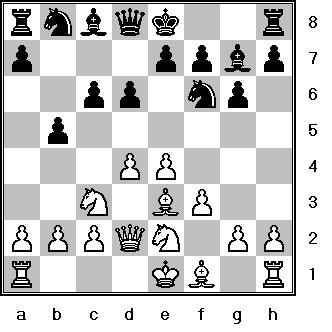
Kasparov chooses piece development. Seirwan feels that 7.0-0-0, Nbd7 8. Bh6 is stronger.
7...Nbd7
8. Bh6
Risky is 8...0-0 as after 9. h4! White has a strong attack.
8....Bxh6
9. Qxh6, Bb7
10. a3!
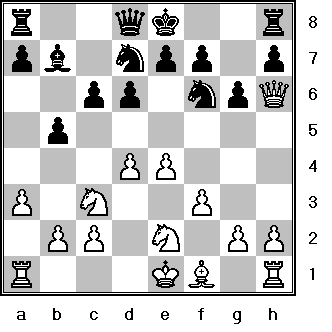
The right moment for prophylaxis. After 10. 0-0-0 black has fine counterplay after 10...b4 and 11...Qa5 according to GM Soltis.
10...e5!
Black claims his fair share of the center.
11. 0-0-0, Qe7
12. Kb1!?
A waiting move. The point is White doesnt want to attack the black kingside until the black king declares its intentions. 12 h4!?, Qf8 is unclear. Seirawan prefers 12. g3 and if 12....0-0-0 then 13. Bh3 is good for white.
12...a6
This prepares the advance....c5 freeing the Bb7.
13. Nc1!

White repositions his knight by preparing the tour Nc3-Nc1-Nb3-Na5.
13....0-0-0
14. Nb3, exd4!
Black plays enterprising chess. With this central break he prepares the advance d6 to d5.
15. Rxd4
White wants to send his knight to a5 so takes back with his rook
15...c5
16. Rd1, Nb6!
Continuing with his plan of playing ...d5 which would completely equalize.
17. g3!

Most players would play Be2
17...Kb8
18. Na5
This is the position that Gary was striving for with his knight, however even stronger is 18. Bh3!
18...Ba8
Black does not want to trade his bishop for the white knight as this would weaken the light squares around his king.
19. Bh3, d5!
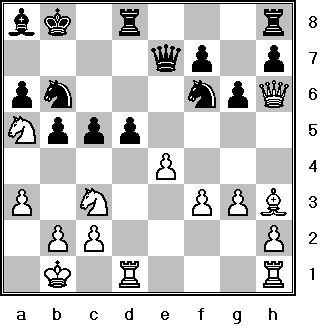
Black has freed his game with this central thrust. GM Soltis notes that "Black appears to stand well and White could have easily end up with a bad-Bishop Middlegame. (20. exd5, Nfxd5; 21. Nxd5, Nxd5; etc.)"
20. Qf4+, Ka7
Bad is 20...Qd6?? when 21.e5 and White wins a piece.
21. Rhe1!
Strengthens e4 and completes the mobilization of White's forces- GM Larry Christiansen.
21...d4

Best. According to GM Soltis "Playing for the advantage. (22. Ne2, Nc4!) Old man hindsight would later say that 21...dxe4; 22. fxe4, and Nd5 was too risky." GM Christiansen gives this further analysis 24.exd5 Qd6 (24...Qxe1?; 25.Qc7+ Bb7 26.Qxb7#) 25.Rxe8 Nxe8 26.Qxf7+ with a clear advantage to White.
The actual text move as played by black shows that he is playing to win. In fact it is White who appears to be in trouble, but...
22. Nd5!
An amazing plan by Gary. He sacrifices a pawn to open up lines to the enemy king, the resulting position becomes extremely complex.
22...Nbxd5
23. exd5, Qd6
If Now 24. Qxd6, Rxd6 or 24. Nc6+ leads to bad endgames for White and Black has a clear advantage according to GM Soltis.
24. Rxd4!!

One of the most shocking moves ever played in modern chess.
Of this move GM Larry Christiansen wrote:"This terrific shot was a basis of the strengthening move 24. Rhe1. White saves his position by finding mating patterns that utilize to the degree his apparently disjointed forces. His seemingly randomly placed Knight and Bishop cooperate in creating mating-nets out of thin air."
This suprising attack out of nowhere is worthy of any brilliancy by the great Alexander Alekhine, who is Kasparov's hero. It truly deserves to be ranked as the greatest attacking game of all time!
24...cxd4
Played after an hours thought by a 2700 plus GM. It must be noted that finding a defense was very difficult as black must place his king in what appears to be in even greater danger to survive. It is also a very difficult task to anticipate whites attack. The current position is very difficult and many of the world's strongest computer programs assess this position as winning for black when in fact he is lost!
Blacks only defense was 24...Kb6! when:
a) 25. Nb3, Bxd5! 26. Qxd6+, Rxd6 27. Rd2, Rhd8 28. Red1, a5! and black survives with a minimal advantage with his greater space though a draw is likely. Or the better:
b) 25.Rxd5! Nxd5 (Not 25...Qxf4?; 26.Rxd8! Qc7; 27.Rxh8, Qxa5; 28.Re7+ Kb6; 29.Rxf7 with Clear advantage to White.) 26.Qxf7+ Nc7 (Forced.) 27.Re6!, Rd7!; 28.Rxd6 Rxf7; 29.Nc6+ Ka8; 30.f4 "when White has a pawn and annoying pressure for the exchange - GM Larry Christiansen. White plans "Bg2" which was "very promising for White" - GM A. Soltis.
25. Re7+!!
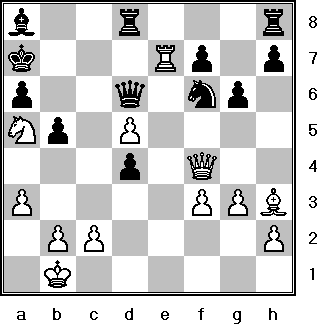
Another very shocking move! It is so unbelievable it looks like a blunder.
25...Kb6
Forced. The following two variations are by GM Garry Kasparov in Informant # 74/110. # 1.) 25...Qxe7? 26.Qxd4+ Kb8; 27.Qb6+, Bb7; 28.Nc6+ Ka8 (The square c8 is guarded by the White Bishop on h3.) 29.Qa7#. Var. # 2.) 25...Kb8? 26.Qxd4 Nd7; This looks like it is forced. Not 26...Rd7??; 27.Rxd7 Nxd7?! 28.Qxh8+ winning. 27.Bxd7!, Bxd5 28.c4! Qxe7 29.Qb6+ Ka8 30.Qxa6+ Kb8 31.Qb6+ Ka8 32.Bc6+! and White wins.
26. Qxd4+

26...Kxa5
Soltis gives the following main alternative: 26...Qc5!? 27.Qxf6+ Qd6; (27...Kxa5??; 28.b4+, which wins Black's Queen.) 28.Be6!! An amazing move, based on the fact that if Pawn captures Bishop, then Rook takes the Pawn on e6 and White wins the Black Queen. 28...Bxd5 Forced as 28...Kxa5; 29.b4+ Ka4; 30.Qc3 Bxd5; 31.Kb2! is winning for white. 29.b4!! Bc6 Forced, to guard d4 and give Black's King an escape square (29...Rhe8??; 30.Qd4+ Qc5; 31.Qxc5#.) 30.Qxf7 Qd1+; 31.Kb2 Qxf3 (31...Qd4+; 32. Ka2, "+/") 32.Rc7!, Qxf7; 33.Rxc6+ Ka7; 34.Bxf7 "and wins." - GM A. Soltis.
27. b4+, Ka4
28. Qc3!?
White threatens mate on b3.
However, GM Lubosh Kavalek found an even better move. 28.Ra7!!, Now play could proceed: 28...Nxd5 29. Bd7!, Rxd7 (Or 29...Rc8!? 30.Qd3 Nc3+; 31.Kb2 Qf6; 32.Qd4!! Nd1+ 33.Kc1! winning) 30. Qb2! Black is helpless to prevent Qb3 without giving back reams of material.
28...Qxd5
Forced as "Black must somehow prevent mates along both the a-file, and also schemes involving Kb2 and Qb3+." - GM L. Christiansen.
29. Ra7

29...Bb7
Other black moves lose this keeps him alive.
30. Rxb7, Qc4
A better try was 30...Rhe8!?; - GM V. Topalov, (shortly after the game). 31. Rb6 Ra8 though after 32. Bf1!! - IM Gert Ligterink. 32...Re1+ 33. Qxe1 Nd7; 34. Rb7!! Qxb7 35. Qd1!! Kxa3 36. c3! And White has a mating net.
31. Qxf6 Kxa3!?
Soltis gives the line: 31...Rd1+; 32.Kb2 Ra8 If 32...Qd4+; 33.Qxd4 Rxd4; 34.Rxf7 winning. 33.Qb6 Qd4+ 34.Qxd4 Rxd4; 35.Rxf7 winning.
32. Qxa6+, Kxb4
33. c3+!!
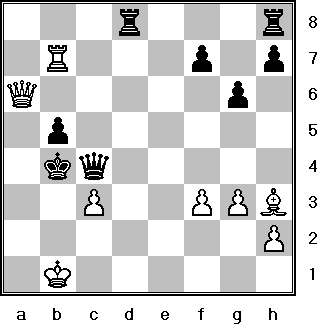
Yet another beautiful move! White attacks Black's King, but further exposes his own king.
33...Kxc3
34. Qa1+, Kd2
35. Qb2+, Kd1
36. Bf1!!
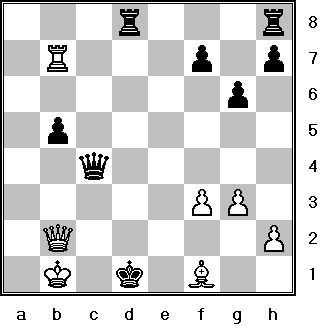
Soltis exclaims: "A fine concluding blow. The Bishop cannot be taken because of because of 37. Qc2+, and 38. Re7+."
36...Rd2
Not 36...Qxf1?! 37.Qc2+ Ke1 38.Re7+ Qe2 39.Qxe2#
37. Rd7!!
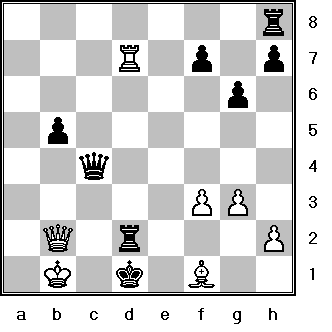
One last tactical body blow!
37...Rxd7
38 Bxc4 bxc4
39 Qxh8
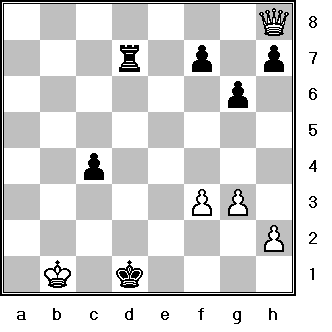
It's over.
39...Rd3
40 Qa8 c3
41 Qa4+ Ke1
42 f4 f5
43 Kc1! Rd2
44 Qa7!
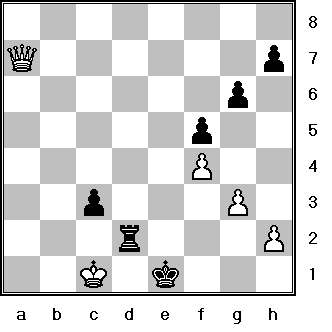
The final position. Black Resigned.
1-0
Tactical Themes: Line opening, demolition, deflection, decoy, piece explotation, pin, double attack
Mating Themes: Knight and Bishop, Rook File Mate, Edge of the Board mate, King and Queen Mate, Queen and Rook mate, Epaullette Mate.
I consider this to be the # 1 Greatest Attacking Game of All Time.